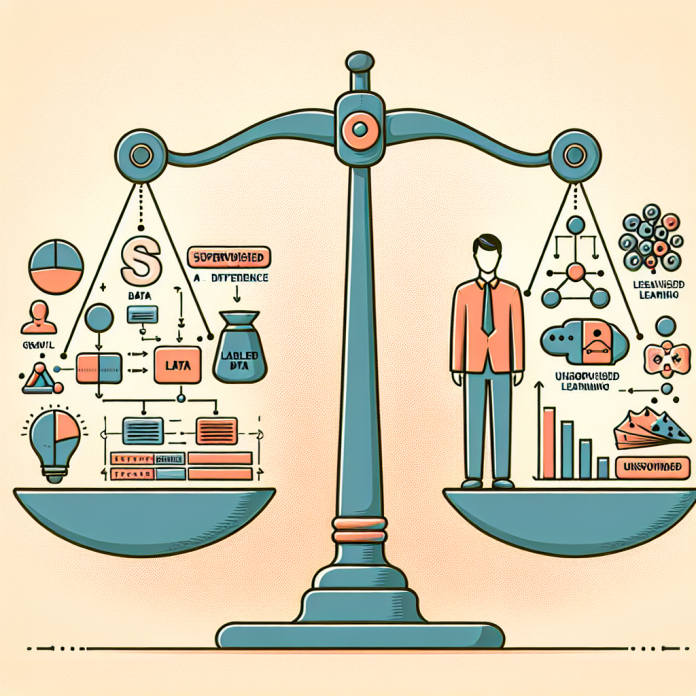Supervised vs. Unsupervised Learning Compared
In the world of machine learning, there are two main categories of algorithms: supervised learning and unsupervised learning. Each of these approaches has its own set of strengths and weaknesses, and understanding the differences between the two can help data scientists and researchers choose the right method for their specific needs. In this article, we will delve into the key distinctions between supervised and unsupervised learning, exploring real-life examples and applications to shed light on their unique characteristics.
### Understanding Supervised Learning
Supervised learning is a type of machine learning algorithm where the model is trained on labeled data, meaning that the input data is paired with the corresponding output. The goal of supervised learning is to learn a mapping function from input variables to output variables based on the labeled training data.
Let’s say we have a dataset of housing prices with features such as the size of the house, number of bedrooms, and location. In supervised learning, we would have labels for each data point indicating the actual sale price of the house. By training a supervised learning model on this data, we can predict the sale price of a new house based on its features.
### Real-life Example: Spam Email Detection
One common example of supervised learning is spam email detection. In this scenario, the algorithm is trained on a dataset of labeled emails, where each email is labeled as either spam or not spam. The model learns to differentiate between spam and non-spam emails based on features such as the sender’s email address, the content of the email, and the subject line.
### The Pros and Cons of Supervised Learning
One of the main advantages of supervised learning is that it can provide accurate predictions when there is a large amount of labeled training data available. Supervised learning models are also easy to interpret, as the output is directly related to the input features.
However, the downside of supervised learning is that it requires manual labeling of the training data, which can be time-consuming and costly. Additionally, supervised learning models may not perform well on unseen data if the training data is not representative of the entire dataset.
### Understanding Unsupervised Learning
Unsupervised learning, on the other hand, is a type of machine learning algorithm where the model is trained on unlabeled data. The goal of unsupervised learning is to discover hidden patterns and structures within the data without explicit guidance in the form of labeled output.
In unsupervised learning, the algorithm learns to group similar data points together based on their intrinsic characteristics. One common technique in unsupervised learning is clustering, where data points are grouped into clusters based on their similarity.
### Real-life Example: Customer Segmentation
An example of unsupervised learning is customer segmentation in marketing. By analyzing customer data such as purchase history, browsing habits, and demographic information, businesses can group customers into segments based on their similarities. This information can then be used to tailor marketing campaigns and personalized recommendations.
### The Pros and Cons of Unsupervised Learning
One of the key advantages of unsupervised learning is its ability to uncover hidden patterns and relationships within the data that may not be apparent to human observers. Unsupervised learning can also be useful in situations where labeled training data is not available or is too costly to obtain.
However, the main challenge of unsupervised learning is evaluating the performance of the model, as there are no explicit labels to compare the predictions against. Unsupervised learning models may also struggle with noisy or ambiguous data, as they rely on the underlying structure of the data to make predictions.
### Key Differences Between Supervised and Unsupervised Learning
– **Guidance:** The main distinction between supervised and unsupervised learning is the presence of labeled data in supervised learning and the absence of labeled data in unsupervised learning.
– **Objective:** Supervised learning aims to predict output variables based on input variables, while unsupervised learning focuses on discovering hidden patterns and structures within the data.
– **Performance:** Supervised learning models are typically more accurate on labeled data, while unsupervised learning models can provide insights into the underlying structure of the data.
– **Data Requirement:** Supervised learning requires labeled training data, while unsupervised learning can work with unlabeled data.
### Conclusion
In conclusion, supervised and unsupervised learning are two fundamental approaches in machine learning that serve different purposes and have distinct advantages and disadvantages. While supervised learning is well-suited for tasks where labeled training data is available and accurate predictions are required, unsupervised learning can be useful in uncovering hidden patterns and relationships within the data.
By understanding the differences between supervised and unsupervised learning, data scientists and researchers can choose the right approach for their specific needs and optimize the performance of their machine learning models. Whether it’s predicting housing prices or segmenting customers, the choice between supervised and unsupervised learning can make a significant impact on the outcomes of a machine learning project.

